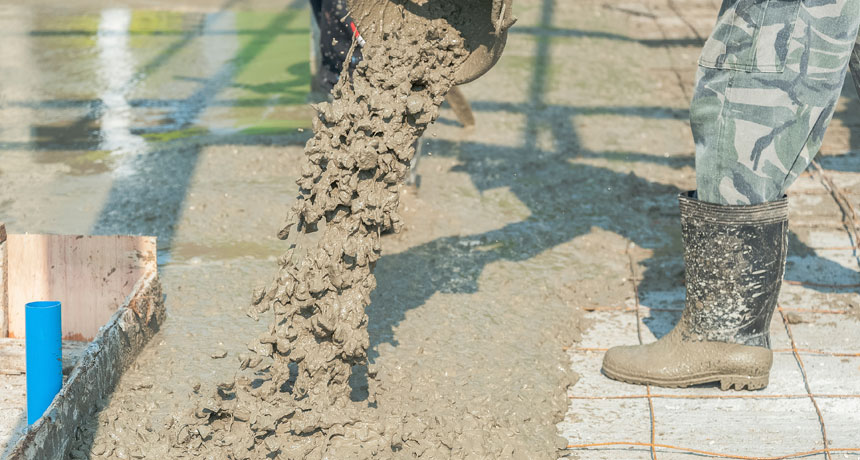Teen adds tiny bits of clay to make cement go with the flow
New cement might one day limit undersea oil spills

Most people don’t think about the cement that binds together the concrete beneath their feet. But one teen did and now is working to make it friendlier to the environment.
ktianngoen0128
WASHINGTON, D.C. — Science is all around us, even in the concrete sidewalks under our feet. Most people might not think much about cement. It’s what binds together the rocky components of the concrete used in buildings, bridges and roads. But cement did catch the attention of Augusta Umwamanzu-Nna. The 17-year-old was determined to find new and environmentally friendly ways of creating this building block of, well, buildings. Now, she reports finding that by adding tiny clay particles to the recipe, liquid cement flows better than ever.
Augusta hopes that her new cement might one day help prevent disasters like the Deepwater Horizon oil spill.
Augusta is a senior at Elmont Memorial High School in New York. She presented her project here at the Intel Science Talent Search, which is run by Society for Science & the Public and sponsored by Intel Corp. in Santa Clara, Calif.. Each year, the search brings together 40 high school seniors to not only present their research to the public but also to compete for huge awards.
Augusta didn’t start off with a passion for cement. “I initially picked something more conventional,” she says — a biology project. “I think it involved planaria,” she says. But she soon felt unsatisfied studying flatworms. She wanted to do something different.
So in 10th grade, the teen began to study cement. She learned that it is made from calcium oxide, along with silicon, iron, aluminum and sulfate. When it is mixed with water, it formed a liquid which can be poured into any shape. As it dries it hardens, binding together bricks and rocks to create strong structures. Manufacturers mix it with sand and usually ground-up rock to produce concrete.
The calcium oxide used in cement is made by burning limestone at a very high temperature. The process releases a large amount of carbon dioxide. But that gas can then build up in Earth’s atmosphere. By acting as a greenhouse gas, it can trap heat near our planet’s surface.
Augusta was horrified to find out that making cement could be bad for the environment. She thought there must be a better way to make this construction material, used in immense quantities the world over.

When Kawashima said she didn’t have room in her lab, “It hurt my heart,” Augusta recalls. But the teen refused to give up. Her science teacher suggested that she try working with crabs. Instead the teen found a summer position with civil engineer Engui Liu at New York University in Brooklyn. There, she learned more about cement and how to predict when structures might need repair.
Augusta kept Kawashima updated about her progress. Finally, the teen was able to join the engineer’s Columbia lab by the summer after Augusta’s junior year. There, the teen continued to tweak the recipe for cement that is used to seal underwater oil wells.
When oil is pumped from areas beneath the ocean floor, it comes out through a pipe. The pipe is surrounded by cement. This blanket of cement keeps oil from leaking into the surrounding area through any cracks that may form. But there can be big consequences when poor-quality cement is used. Faulty cement around the pipes contributed to the 2010 Deepwater Horizon oil spill in the Gulf of Mexico. That incident dumped millions of barrels of oil into the surrounding water. Years later, the spill is still affecting the local environment.
Augusta set out to improve the cement used in these oil wells. She found that adding very fine particles of clay, called nanoclay, helped the cement to flow more evenly as was poured. The teen showed that only 0.3 percent of the nanoclay needs to be added to see an improvement.
The teen’s project has made her look at cement in a whole new light. Before, “I would just take a bridge for granted, [never] knowing it was so sensitive,” she says. But now, she sees how important building materials can be. So far, Augusta’s cement has been tested only in the lab. One day, she hopes, it might be applied to oil wells to limit the risk of devastating spills.
Follow Eureka! Lab on Twitter
Power Words
(for more about Power Words, click here)
atmosphere The envelope of gases surrounding Earth or another planet.
biology The study of living things. The scientists who study them are known as biologists.
calcium oxide A substance that gives off heat as it chemically reacts with water. Its chemical formula is CaO (which means each molecule is made up of one calcium atom and one oxygen atom).
carbon dioxide (or CO2) A colorless, odorless gas produced by all animals when the oxygen they inhale reacts with the carbon-rich foods that they’ve eaten. Carbon dioxide also is released when organic matter (including fossil fuels like oil or gas) is burned. Carbon dioxide acts as a greenhouse gas, trapping heat in Earth’s atmosphere. Plants convert carbon dioxide into oxygen during photosynthesis, the process they use to make their own food.
cement A finely ground material used to bind sand or bits of ground rock together in concrete. Cement typically starts out as a powder. But once wet, it becomes a mudlike sludge that hardens as it dries.
ceramic A hard but brittle material made by firing clay or some other non-metal-based mineral at a high temperature. Bricks, porcelain and other types of earthenware are examples of ceramics. Many high-performance ceramics are used in industry where materials must withstand harsh conditions.
civil engineer An engineer who creates buildings, tunnels, water systems and other large projects that improve everyday life.
clay Fine-grained particles of soil that stick together and can be molded when wet. When fired under intense heat, clay can become hard and brittle. That’s why it’s used to fashion pottery and bricks.
climate change Long-term, significant change in the climate of Earth. It can happen naturally or in response to human activities, including the burning of fossil fuels and clearing of forests.
concrete (in construction) A simple, two-part building material. One part is made of sand or ground-up bits of rock. The other is made of cement, which hardens and helps bind the grains of material together.
environment The sum of all of the things that exist around some organism or the process and the condition those things create for that organism or process. Environment may refer to the weather and ecosystem in which some animal lives, or, perhaps, the temperature, humidity and placement of components in some electronics system or product.
greenhouse gas A gas that contributes to the greenhouse effect by absorbing heat. Carbon dioxide is one example of a greenhouse gas.
Intel Science Talent Search An annual competition created and run by Society for Science & the Public and sponsored by Intel Corp. Begun in 1950, this event brings 40 research-oriented high school seniors to Washington, D.C. to showcase their research to the public and to compete for awards.
limestone A natural rock formed by the accumulation of calcium carbonate over time, then compressed under great pressure. Most of the starting calcium carbonate came from the shells of sea animals after they died. However, that chemical also can settle out of water, especially after carbon dioxide is removed (by plants, for instance).
nano A prefix indicating a billionth. In the metric system of measurements, it’s often used as an abbreviation to refer to objects that are a billionth of a meter long or in diameter.
planarian (plural planaria) A genus of flatworms. They have the ability to regenerate lost body parts.
Society for Science and the Public (or SSP) A nonprofit organization created in 1921 and based in Washington, D.C. Since its founding, SSP has been not only promoting public engagement in scientific research but also the public understanding of science. It created and continues to run three renowned science competitions: The Intel Science Talent Search (begun in 1942), the Intel International Science and Engineering Fair (initially launched in 1950) and Broadcom MASTERS (created in 2010). SSP also publishes award-winning journalism: in Science News (launched in 1922) and Science News for Students (created in 2003). Those magazines also host a series of blogs (including Eureka! Lab).